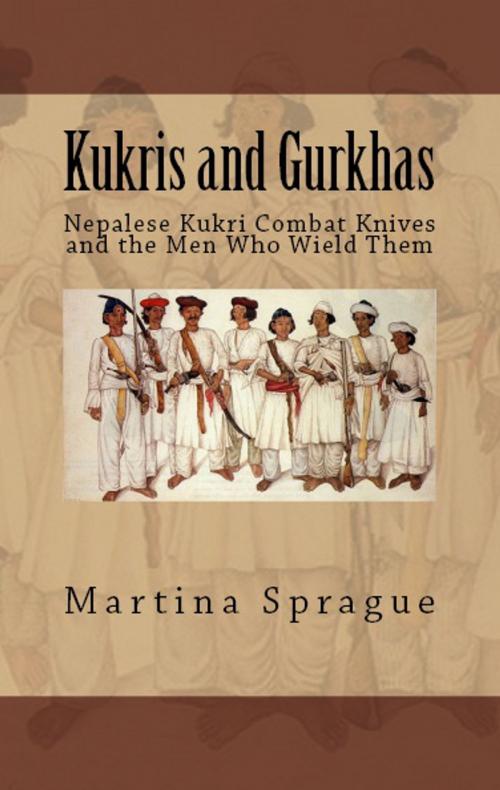Kukris and Gurkhas
Nepalese Kukri Combat Knives and the Men Who Wield Them
Nonfiction, History, Military, Weapons| Author: | Martina Sprague | ISBN: | 1230000134325 |
| Publisher: | Martina Sprague | Publication: | May 20, 2013 |
| Imprint: | Language: | English |
| Author: | Martina Sprague |
| ISBN: | 1230000134325 |
| Publisher: | Martina Sprague |
| Publication: | May 20, 2013 |
| Imprint: | |
| Language: | English |
The Gurkhas have been termed the only soldiers who can win their battles on their reputation alone. Weapons shape the character of the men who wield them and two upturned kukris meeting at the top, their naked blades crossing, serve as the identifying insignia of the Brigade of Gurkhas in the United Kingdom.
The Gurkhas were brought to the world’s attention in the nineteenth century, when the territory ruled by Britain’s Honourable East India Company in Nepal experienced a number of boundary disputes and Gurkha raids. Mutual respect developed between the Gurkhas and the British, who viewed the Gurkhas as disciplined and capable fighters training under the motto, “It is better to die than to be a coward.”
In modern times the Gurkhas have served the British Crown in several campaigns worldwide, including both World Wars. As World War II ended Gurkhas saw active service mainly in the Far East, until Britain moved forward to defend the Falkland Islands following the Argentine occupation in the spring of 1982.
This book examines the kukri knife as a combat weapon and relates it to the history of the Gurkha soldier. It starts with a historical background of the Gurkhas, including an account of the campaigns in which they have fought. It then explores the origin and handling characteristics of the kukri and its combat applications. Next it discusses Gurkha recruitment into the British and Indian armies, followed by an examination of the status of Gurkhas as mercenary soldiers. The book summarizes with a discussion of the Gurkha reputation as the “bravest of the brave.” The concluding remarks focus on the Gurkhas’ so-called “inherent” fighting characteristics and the kukri knife as a symbol of status and skill.
Knives, Swords, and Bayonets: A World History of Edged Weapon Warfare is a book series that examines the history of edged weapons in Europe, Asia, Africa, the Americas, and the Middle East and surrounding areas before gunpowder increased the distance between combatants. The book series takes a critical look at the relationship between the soldier, his weapon, and the social and political mores of the times. Each book examines the historical background and metallurgic science of the knife, sword, or bayonet respectively, and explores the handling characteristics and combat applications of each weapon. The individual books are excerpted from the previously published book, A History of Edged Weapon Warfare, also by Martina Sprague. Look for more books in this series in the near future.
The Gurkhas have been termed the only soldiers who can win their battles on their reputation alone. Weapons shape the character of the men who wield them and two upturned kukris meeting at the top, their naked blades crossing, serve as the identifying insignia of the Brigade of Gurkhas in the United Kingdom.
The Gurkhas were brought to the world’s attention in the nineteenth century, when the territory ruled by Britain’s Honourable East India Company in Nepal experienced a number of boundary disputes and Gurkha raids. Mutual respect developed between the Gurkhas and the British, who viewed the Gurkhas as disciplined and capable fighters training under the motto, “It is better to die than to be a coward.”
In modern times the Gurkhas have served the British Crown in several campaigns worldwide, including both World Wars. As World War II ended Gurkhas saw active service mainly in the Far East, until Britain moved forward to defend the Falkland Islands following the Argentine occupation in the spring of 1982.
This book examines the kukri knife as a combat weapon and relates it to the history of the Gurkha soldier. It starts with a historical background of the Gurkhas, including an account of the campaigns in which they have fought. It then explores the origin and handling characteristics of the kukri and its combat applications. Next it discusses Gurkha recruitment into the British and Indian armies, followed by an examination of the status of Gurkhas as mercenary soldiers. The book summarizes with a discussion of the Gurkha reputation as the “bravest of the brave.” The concluding remarks focus on the Gurkhas’ so-called “inherent” fighting characteristics and the kukri knife as a symbol of status and skill.
Knives, Swords, and Bayonets: A World History of Edged Weapon Warfare is a book series that examines the history of edged weapons in Europe, Asia, Africa, the Americas, and the Middle East and surrounding areas before gunpowder increased the distance between combatants. The book series takes a critical look at the relationship between the soldier, his weapon, and the social and political mores of the times. Each book examines the historical background and metallurgic science of the knife, sword, or bayonet respectively, and explores the handling characteristics and combat applications of each weapon. The individual books are excerpted from the previously published book, A History of Edged Weapon Warfare, also by Martina Sprague. Look for more books in this series in the near future.















